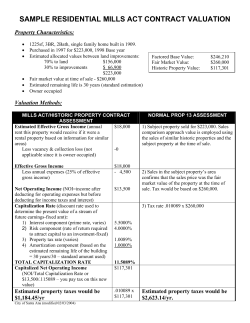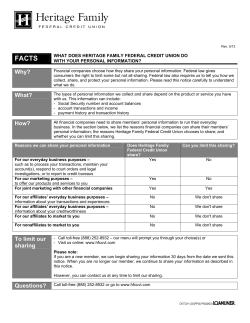
WHY LOCAL GOVERNMENT NEEDS ARCHAEOLOGY ADVISORS 1. England’s heritage
WHY LOCAL GOVERNMENT NEEDS ARCHAEOLOGY ADVISORS 1. England’s heritage England’s heritage plays a major role in economic regeneration and prosperity, promoting inward investment, business growth and relocation and, in many areas, tourism http://hc.english‐ heritage.org.uk/ Only 5% of England’s heritage is designated and protected by law. The rest depends for its care and protection on a network of local authority historic environment specialists including archaeology advisors. In 2010 there were 370 archaeology advisors in local authorities in England. They play a critical role in ensuring that the planning process takes account of the impact of new development on sites of potential archaeological importance. Where the benefits of development outweigh those of protection, heritage assets are investigated, recorded and published by qualified professionals. In 2008, there were about 20,000 archaeological projects in England, employing over 3,000 people, and with a total value of £100‐£150m http://www.archaeologists.net/sites/default/files/node‐files/Profiling_the_Profession_2007‐8.pdf 2. Policy context Environmental Impact Assessment Under the Environmental Impact Assessment (EIA) Regulations, the historic environment must be taken into account in planning major developments, and its assessment included within the scope of Environmental Statements http://www.legislation.gov.uk/uksi/1999/293/contents/made The government’s vision The value of the historic environment “is recognised by all who have the power to shape it; that Government gives it proper recognition and that it is managed intelligently and in a way that fully realises its contribution to the economic, social and cultural life of the nation” http://webarchive.nationalarchives.gov.uk/+/http://www.culture.gov.uk/reference_library/publicati ons/6763.aspx Planning Policy Statement 5: Planning for the Historic Environment (PPS5) PPS5 establishes the historic environment, whether designated or not, as a material consideration in the planning process, and provides guidance on how to sustain and enhance its significance and setting. It emphasises the need for pre‐application consultation, assessment and expert advice to inform local authority decision making, and for the recording, publication and archiving of heritage assets lost to development http://www.communities.gov.uk/publications/planningandbuilding/pps5 The National Planning Policy Framework The government intends to replace existing planning guidance with a national planning policy framework, to simplify and localise the planning process and help promote sustainable development. However, government has indicated its intention to carry forward the principles of PPS5 into the new planning framework http://www.communities.gov.uk/news/corporate/1804403 Localism The Localism Bill is designed to decentralise power to local communities. It includes proposals to introduce Neighbourhood Planning, reform the Community Infrastructure Levy, and introduce rights for community groups to purchase assets of community value and bid to run non‐statutory local authority services. http://www.communities.gov.uk/localgovernment/decentralisation/localismbill/ 3. Local government archaeology advisors England’s local authorities currently enjoy access to a comprehensive network of archaeology advisors, offering a range of specialist skills in the built, buried, coastal and submerged historic environment. They provide advice that is proportionate, consistent, informed, impartial and timely. They can advise on • Implementing national planning guidance to sustain and enhance the significance and setting of local heritage assets • Strategic and local historic environment policies in Local Development Frameworks and Neighbourhood Development Plans • The adequacy of Environmental Impact Assessments and Environmental Statements • Pre‐application consultation on development proposals • Screening planning applications and Neighbourhood Development Orders to assess their impact on the significance and setting of heritage assets and local distinctiveness • Measures necessary to conserve or record heritage assets affected by planning applications and Neighbourhood Development Orders • Appeals and Public Inquiries • Maintenance, transfer or disposal of assets of community value • Potential devolution of English Heritage powers or resources to local partners and communities • Identifying heritage‐led regeneration opportunities • Promoting place‐shaping in new and existing communities • Promoting localism through community engagement and volunteering opportunities • Maximising grant aid through English Heritage, the Heritage Lottery Fund, the Community Infrastructure Levy and Environmental Stewardship 4. Historic Environment Records (HERs) The bedrock of any historic environment service is the Historic Environment Record (HER), which should be a comprehensive, accessible and authoritative record of the local historic environment. England has a complete network of HERs, containing information on over 1.5 million heritage assets. The HER is used to formulate advice to local authorities for informed planning and decision making, to communities engaged in neighbourhood planning, and to inform those who develop, manage, interpret or study the local historic environment. But the HER is not a static record. It needs to be continuously managed and updated to reflect the changing nature of the historic environment as a result of new discoveries, designations, investigations, interpretations and changes in use, management or significance. 5. Critical mass Experience has shown that it is essential for the archaeology advisor to be co‐located with the HER, in order to provide a cost‐effective one‐stop response to commercial enquiries, to ensure the HER is continuously updated with new casework, and to maintain the critical mass of an effective service. The scale of the local authority historic environment service must be proportionate to the extent, nature and condition of the local heritage resource, the risk of its development, the capacity of the local authority to sustain it, and the feasibility or otherwise of alternative forms of service delivery.
© Copyright 2025





















